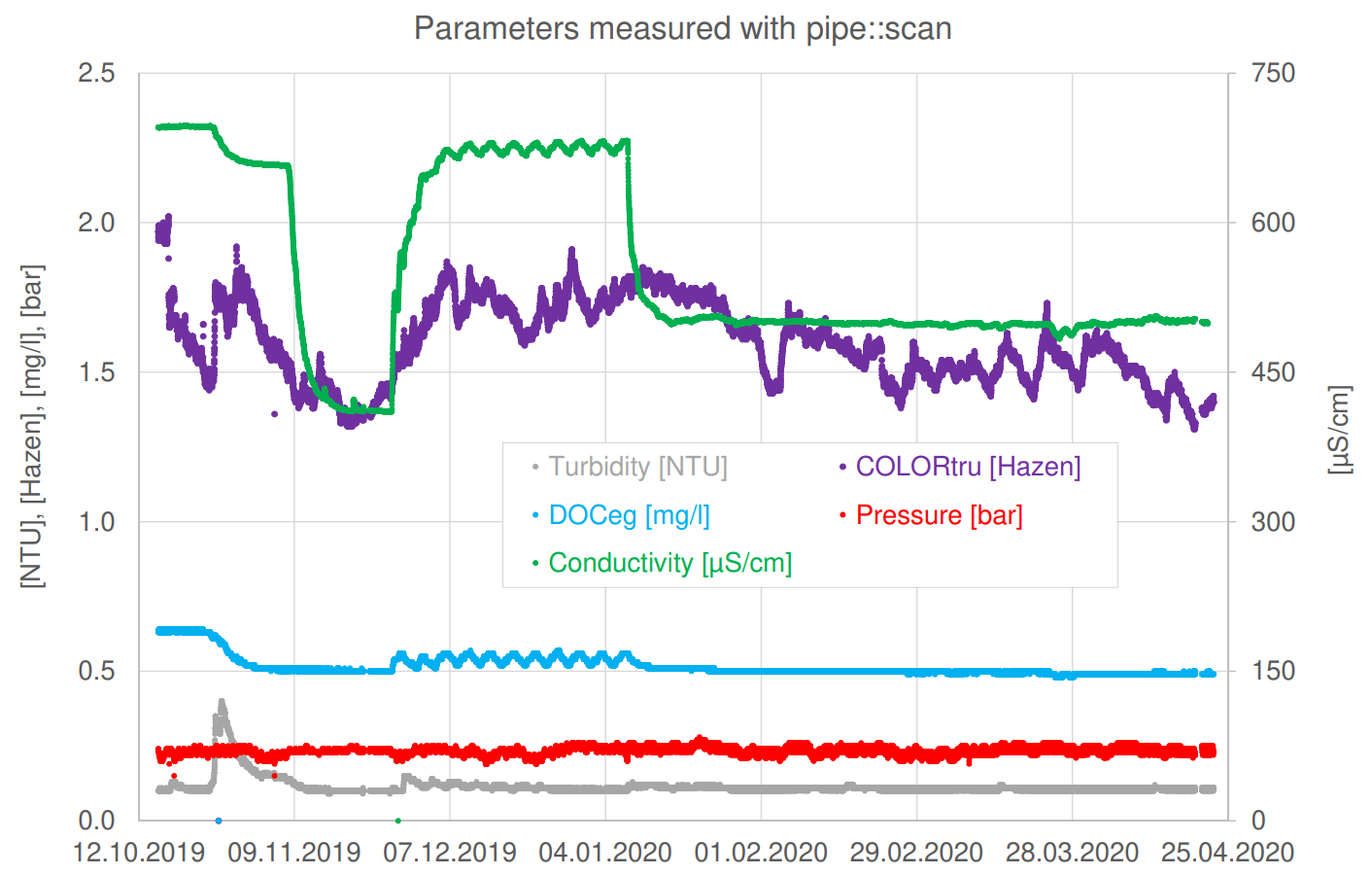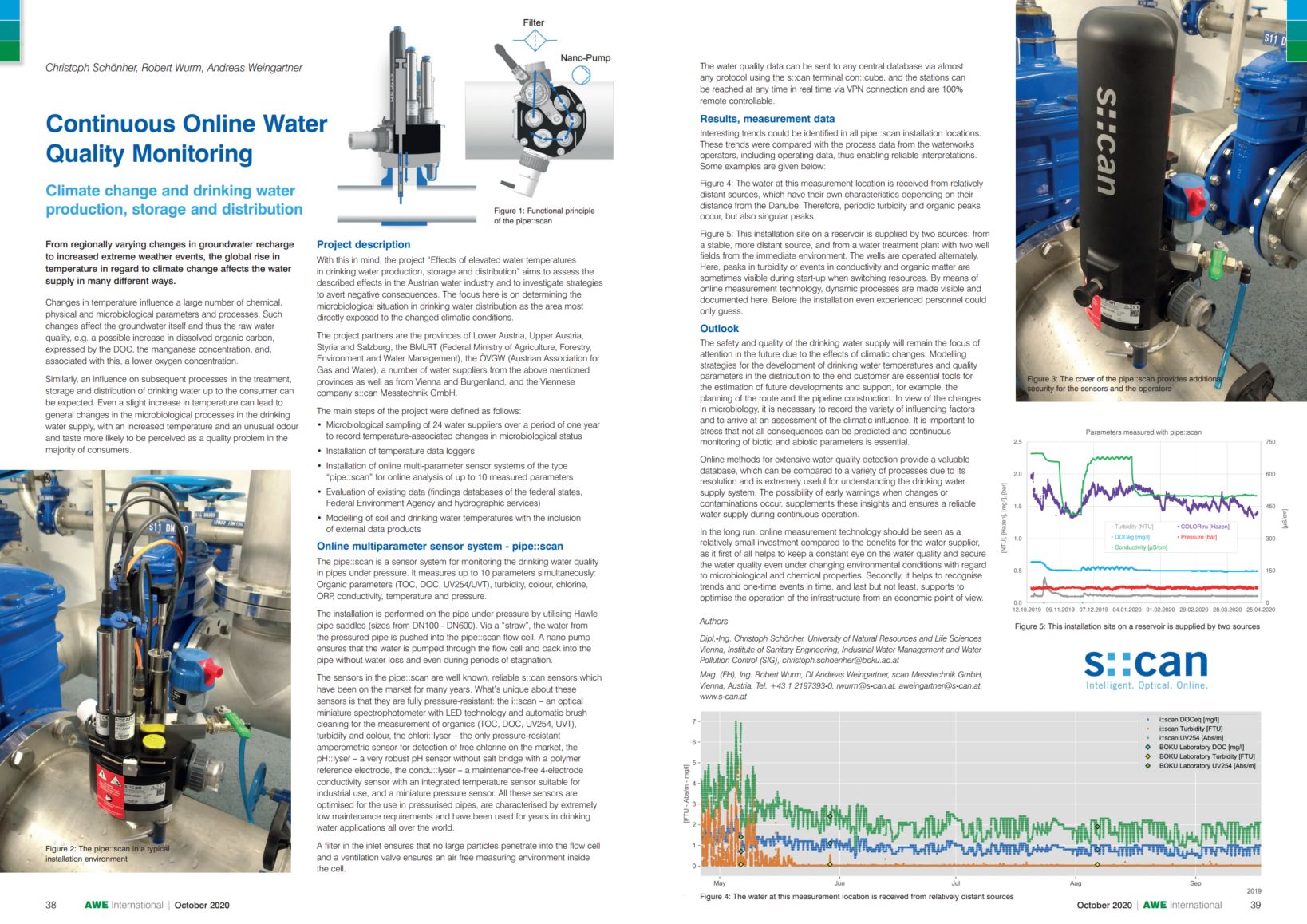The global rise in temperature in regard to climate change affects the water supply in many different ways. In Austria, for example, regionally varying changes in groundwater recharge are expected. Another direct consequence of climate change is the increased number of extreme weather events in the form of heat waves. The increasing temperature has a particular impact on the temperature balance of groundwater, while heat waves are a very direct consequence of climate change in the distribution of drinking water to the consumer.
The importance of continuous online water quality monitoring in drinking water production, storage and distribution in regard to climate change

Project description
Changes in temperature influence a large number of chemical, physical and microbiological parameters and processes. Such changes affect the groundwater itself and thus the raw water quality, e.g. a possible increase in dissolved organic carbon, expressed by the DOC, the manganese concentration, and, associated with this, a lower oxygen concentration. Similarly, an influence on subsequent processes in the treatment, storage and distribution of drinking water up to the consumer can be expected. The superimposition with a changed utilization behavior, changed flow rates and changes in pipeline construction (pipe material, bedding material, multiple troughs) create new environmental conditions, which can additionally intensify climatic effects.
The majority of consumers interpret low drinking water temperatures (especially in the summer months) as an indication of high quality and freshness of the drinking water. In contrast, an increased temperature and an unusual odor and taste are more likely to be perceived as a quality problem.
Even a slight increase in temperature can lead to general changes in the microbiological processes in the drinking water supply. These changes can be noticed by a change in the microbiological stability of the distributed water or the tendency of re-infection. Depending on the chemical-physical and microbiological raw and pure water quality and specific operational boundary conditions, undesirable reductions of the “usual” drinking water quality (especially CFU, coliform bacteria) can occur.
A more precise and meaningful investigation of the above-mentioned changes and their possible interactions with the safety and quality of drinking water supply has increasingly become the focus of attention in the water industry in the past years. At the same time, innovative, highly sensitive and efficient analytical methods have been developed that can be used for a more in-depth investigation of these issues, such as:.
- Online monitoring of chemical and physical properties (e.g. organics, turbidity, electrical conductivity, temperature)
- (Online) flow cytometry for very accurate and fast determination of the total number of bacterial cells in a water sample
- DNA sequencing method for the determination of the species composition of the entire bacterial community
Project description
The project “Effects of elevated water temperatures in drinking water production, storage and distribution” aims to assess the described effects in the Austrian water industry and to investigate strategies to avert negative consequences. The focus here is on determining the microbiological situation in drinking water distribution as the area most directly exposed to the changed climatic conditions. The project partners are the provinces of Lower Austria, Upper Austria, Styria and Salzburg, the BMLRT (Federal Ministry of Agriculture, Forestry, Environment and Water Management), the ÖVGW (Austrian Association for Gas and Water), a number of water suppliers from the above mentioned provinces as well as from Vienna and Burgenland, and the Viennese company s::can Messtechnik GmbH. The main steps of the project were defined as follows:
- Microbiological sampling of 24 water suppliers over a period of one year to record temperature-associated changes in microbiological status
- Installation of temperature data loggers
- Installation of online multi-parameter sensor systems of the type “pipe::scan” for online analysis of up to 10 measured parameters
- Evaluation of existing data (findings databases of the federal states, Federal Environment Agency and hydrographic services)
- Modelling of soil and drinking water temperatures with the inclusion of external data products
The results of the project provide information on the effects of increased temperature and all online quality parameters on water management operations in terms of supply security, stability and quality, as well as creating a data basis for findings, expert services and training on the one hand, and for future investment planning in the drinking water supply on the other.
Online multiparameter sensor system – pipe::scan
The pipe::scan is a sensor system for monitoring the drinking water quality in pipes under pressure. It measures up to 10 parameters simultaneously: Organic parameters (TOC, DOC, UV254/UVT), turbidity, color, chlorine, ORP, conductivity, temperature and pressure.
The installation is performed on the pipe under pressure by utilizing Hawle pipe saddles (sizes from DN100 – DN600). Via a “straw”, the water from the pressured pipe is pushed into the pipe::scan flow cell. A nano pump ensures that the water is pumped through the flow cell and back into the pipe without water loss and even during periods of stagnation.
Figure 1: Functional principle of the pipe::scan
Figure 2: The pipe::scan in a typical installation environment
Figure 3: The cover of the pipe::scan provides additional security for the sensor and the operators
The sensors in the pipe::scan are well known, reliable s::can sensors which have been on the market for many years. What’s unique about these sensors is that they are fully pressure-resistant: the i::scan – an optical miniature spectrophotometer with LED technology and automatic brush cleaning for the measurement of organics (TOC, DOC, UV254, UVT), turbidity and colour, the chlori::lyser – the only pressure-resistant amperometric sensor for detection of free chlorine on the market, the pH::lyser – a very robust pH sensor without salt bridge with a polymer reference electrode, the condu::lyser – a maintenance-free 4-electrode conductivity sensor with an integrated temperature sensor suitable for industrial use, and a miniature pressure sensor. All these sensors are optimized for the use in pressurized pipes, are characterized by extremely low maintenance requirements and have been used for years in drinking water applications all over the world.
A filter in the inlet ensures that no large particles penetrate into the flow cell and a ventilation valve ensures an air free measuring environment inside the cell. Optionally, the system can automatically clean this filter and automatically take samples in case of an alarm.
The water quality data can be sent to any central database via almost any protocol using the s::can terminal con::cube, and the stations can be reached at any time in real time via VPN connection and are 100% remote controllable.
Results, measurement data
Interesting trends could be identified in all pipe::scan installation locations. These trends were compared with the process data from the waterworks operators, including operating data, thus enabling reliable interpretations. Some examples are given below:
Figure 4: The water at this measurement location is received from relatively distant sources, which have their own characteristics depending on their distance from the Danube. Therefore, periodic turbidity and organic peaks occur, but also singular peaks. The online measurements are validated and evaluated in the BOKU laboratory.
Figure 5: This installation site on a reservoir is supplied by two sources: from a stable, more distant source, and from a water treatment plant with two well fields from the immediate environment. The wells are operated alternately. Here, peaks in turbidity or events in conductivity and organic matter are sometimes visible during start-up when switching resources. By means of online measurement technology, dynamic processes are made visible and documented here. Before the installation even experienced personnel could only guess.
Outlook
The safety and quality of the drinking water supply will remain the focus of attention in the future due to the effects of climatic changes. Modelling strategies for the development of drinking water temperatures and quality parameters in the distribution to the end customer are essential tools for the estimation of future developments and support, for example, the planning of the route and the pipeline construction. In view of the changes in microbiology, it is necessary to record the variety of influencing factors and to arrive at an assessment of the climatic influence. It is important to stress that not all consequences can be predicted and continuous monitoring of biotic and abiotic parameters is essential.
Online methods for extensive water quality detection provide a valuable database, which can be compared to a variety of processes due to its resolution and is extremely useful for understanding the drinking water supply system. The possibility of early warnings when changes or contaminations occur, supplements these insights and ensures a reliable water supply during continuous operation.
In the long run, online measurement technology should be seen as a relatively small investment compared to the benefits for the water supplier, as it first of all helps to keep a constant eye on the water quality and secure the water quality even under changing environmental conditions with regard to microbiological and chemical properties. Secondly, it helps to recognize trends and one-time events in time, and last but not least, supports to optimize the operation of the infrastructure from an economic point of view.
Authors: Dipl.-Ing. Christoph Schönher, University of Natural Resources and Life Sciences Vienna, Institute of Sanitary Engineering, Industrial Water Management and Water Pollution Control (SIG), Mag. (FH), Ing. Robert Wurm, DI Andreas Weingartner, scan Messtechnik GmbH
Download Publication(Se abre en una nueva pestaña o ventana)





